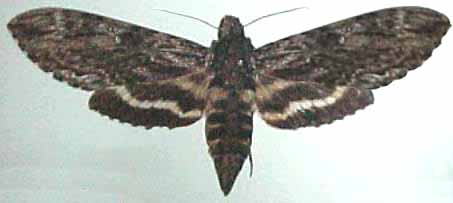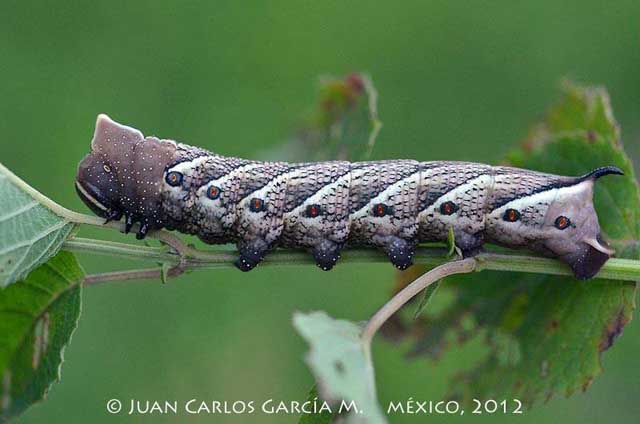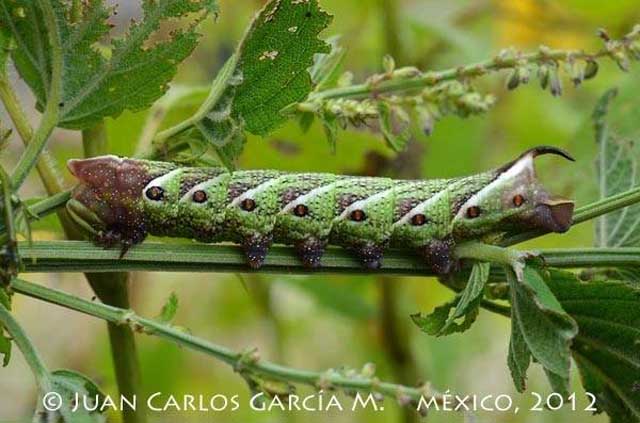Lintneria lugens
(Walker, 1856) Sphinx

Lintneria lugens,
Nicaragua, MAES J.M.
Sphingidae & Saturniidae of Nicaragua CD ROM.
This site has been created by
Bill Oehlke at oehlkew@islandtelecom.com
Comments, suggestions and/or additional information are welcomed by Bill.
TAXONOMY:
Family: Sphingidae, Latreille, 1802
Subfamily: Smerinthinae, Grote & Robinson, 1865
Tribe: Sphingini, Latreille, 1802
Genus: Lintneria Butler, 1876 ...........
Species: lugens Walker, 1856
|
MIDI MUSIC
.....It's a Wonderful World.....
copyright C. Odenkirk
ON.OFF
<bgsound src="world.mid" LOOP=FOREVER>
|
DISTRIBUTION:
Lintneria lugens
flies in
Mexico, the specimen type locality: Michoacan; Jalisoco; Oaxaca and
Honduras and
Nicaragua.
Ian Kitching reports that L. istar, separatus, geminus, lugens and L. pseudostigmatica have all been confirmed from Michoacan, Mexico.
In his The Hawk Moths of North America, 2007, James P. Tuttle has assigned all the
Sphinx genus species from Mexico south throughout South American to Lintneria, Butler, 1876, based on
consistent differences in wing characters and significant larval differences.
FLIGHT TIMES:
Lintneria lugens adults probably fly as a single brood from July-September.
ECLOSION:
Pupae wiggle to surface from subterranean chambers just prior to eclosion.
SCENTING AND MATING:
Females call in the males with a pheromone released from a gland at the tip of the
abdomen. Adults nectar at a variety of flowers.
EGGS, LARVAE, PUPAE:
Under natural conditions larvae feed exclusively on the leaves of the shrub Wigandia urens
(Ruiz & Pavón) of the Hydrophyllaceae family. There are two types of leaves of W. urens:
"a) smooth leaves without urticant trichomes and lower concentrations of N, P and water, and
b) bristly leaves with urticant trichomes and higher concentrations of N, P and water.
Third instar larvae of S. lugens were fed experimentally with these two types of leaves of W. urens to
know the effect of trichomes and nutritional quality on the development of this insect. Larvae treated with bristly
leaves had a higher fresh weight from 11 to 21 days, and from 27 to 33 days than those treated with smooth leaves.
Fourth instar duration was shorter in larvae fed with bristly leaves. However, larvae weights in the fourth,
fifth instars and prepupa were similar. Differences found in the growth and development of S. lugens can be
correlated with higher concentrations of N, P and water of bristly
leaves. "
Larvae are also reported to feed on
Andromeda in the Ericaceae family,
Forestiera pubescens in the Oleaceae family, and
Salvia azurea and Salvia lanceolata in the
Labiatae family.

Lintneria fifth instar, Tlalpujaha, Michoacan, Mexico,
possibly L. smithi (BO), more likely L. lugens (JH), 2012, 2500m, courtesy of Juan Carlos Garcia.

Lintneria fourth or fifth instar, Tlalpujaha, Michoacan, Mexico,
possibly L. smithi (BO), more likely L. lugens (JH), 2012, 2500m, courtesy of Juan Carlos Garcia.
Jean Haxaire and Ian Kitching have indicated to me that S. smithi populations in Mexico, as of May 21, 2015, are thought to be limited to northern Mexico,
suggesting that it is much more likely the larvae from Michoacan, are probably something other than smithi, and by process of elimination, L. lugens
seems the best choice.
Please visit my special request for images of Lintneria species larvae at
Lintneria larvae, and help if you can.
It is anticipated that the Lintneria larvae will most often be encountered on Lamiaceae: Salvia (Sage), Mentha (Mints), Monarda (Beebalm) and
Hyptis (Bushmints); Verbenaceae: Verbena and Lantana camara (shrub verbenas or lantanas).
Although they may be encountered feeding during daylight hours, one is even more likely to discover them feeding in the evening or after dark.
Two of the greatest clues for discovering larvae are stripped foliage and droppings beneath the plant. You might be quite surprised at what will turn up in the evening or
after dark in a flashlight assisted search.
It is believed that all "Lintneria larvae will exhibit "a fleshy thoracic dorsal "horn" in the first 4 instars (unique in the Sphingidae of the world to my
knowledge) which is replaced by a thoracic dorsal "hump" with a large black patch in the 5th instar." J.A. Tuttle.
Return to Sphingidae Index
Return to Sphingini Tribe
Use your browser "Back" button to return to the previous page.
This page is brought to you by
Bill Oehlke and the
WLSS. Pages are on space rented from Bizland. If you would like
to become a "Patron of the Sphingidae Site", contact Bill.
Please send sightings/images to Bill. I will do my best to respond to
requests for identification help.
Enjoy one of nature's wonderments: Live
Saturniidae (Giant Silkmoth) cocoons.
 | 
Show appreciation for this site by clicking on flashing butterfly to the left.
The link will take you to a page with links to many insect sites. |




